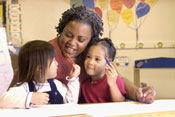Early ChildhoodWhen does a child learn to read? Many would answer kindergarten or first grade. But researchers have found strong evidence that children can begin to learn reading and writing in their earliest years, long before they go to school. The Institute identifies scientifically based research on how young children develop skills that will make them successful readers and makes it available in publications for parents, families, and caregivers. The Institute's publications offer advice on how to support reading development at home and how to recognize preschool and day care activities that start children on the road to becoming readers. To help build a body of knowledge on young children's literacy, the Institute funded a group of nine nationally recognized experts, known as the National Early Literacy Panel to review the research on language, literacy, and communication in young children ages birth through five. The Panel's work (1.5 MB PDF) answered research questions designed to identify the skills and abilities of young children that predict later reading outcomes. It also responded to questions about the environments and settings that contribute to or inhibit gains in children's skills; children's characteristics that contribute to or inhibit gains in the skills and abilities linked to later outcomes in reading; and programs and interventions that contribute to or inhibit gains in those same skills and abilities. The Institute is also developing a report on preschool literacy professional development practices identified as successful by the national evaluation of Early Reading First (ERF) programs. The Institute provided $1 million to the Institute for Education Sciences (IES) for the ERF national evaluation, which gathered information on the extent to which: (1) ERF improves children's skills in oral language, phonological awareness, print awareness, and alphabet knowledge; (2) the quality of language and literacy instruction, practice, and materials differ between ERF preschools and non-ERF preschools; and (3) variations in ERF program quality and implementation associated with differences in participants' outcomes. |

|